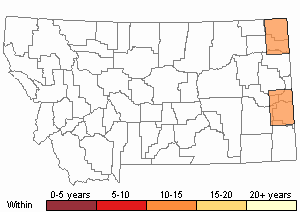View in other NatureServe Network Field Guides
NatureServe
Montana
Utah
Wyoming
Idaho
Wisconsin
British Columbia
South Carolina
Yukon
California
New York
Dutch Elm Disease Fungus - Ophiostoma ulmi
State Rank Reason (see State Rank above)
Species is not native to Montana and therefore cannot be assigned a status rank (SNA).
General Description
Ophiostoma ulmi is one of two fungal pathogens that cause Dutch Elm Disease in elm trees (Ulmaceae). This disease is of great concern as infection is lethal to some species of elm. In the 50 years following its introduction in 1931 the disease killed an estimated 77 million elm trees. Across its introduced range in North America, Europe, and New Zealand the disease has killed over 1 billion elms (Paoletti et al. 2006). This mortality is the combined effect of two related species of pathogenic fungi. O. ulmi is believed to have caused the first outbreak, while O. novo-ulmi is thought to be responsible the more recent outbreak which hit North America in the 1940s (Bernier 2016).
The pathology of infection typically begins with the browning of the foliage on an upper level branch, which can spread quickly or gradually to the rest of the tree and cause death of the host. The fungus is spread between host trees by native and invasive bark beetle species (Hylurgopinus rufipes and Scolytus spp.) as well as root grafts between trees in proximity to one another.
Diagnostic Characteristics
Infection of Ophiostoma fungus is initially marked by death of the foliage on upper branches. To diagnose the disease, the xylem of branches showing symptoms must be examined. Typically these will have a characteristic staining of the xylem and streaks or discoloration of wood under the bark. Although these characteristics can be used to identify a probable infection, positive identification of the disease or the Ophiostoma species responsible is only possible through submission of infected tissue to a laboratory. If Dutch Elm Disease is suspected collect a sample from a live infected limb and submit this to your county extension office.
Range Comments
Dutch elm disease is broadly distributed across the United States, particularly in urban areas with ornamental elm populations. The disease has been documented across urban areas of both west and eastern Montana.
Observations in Montana Natural Heritage Program Database
Number of Observations: 6
(Click on the following maps and charts to see full sized version)
Map Help and Descriptions
Relative Density

Recency


 (Observations spanning multiple months or years are excluded from time charts)
(Observations spanning multiple months or years are excluded from time charts)
Habitat
In North America this fungus may be found wherever suitable hosts (elm species) and insect vectors (Hylurgopinus rufipes and Scolytus spp.) exist.
Ecology
Infection spreads to a host tree one of two ways. Spores of O. ulmi can be introduced into a host tree by bark beetles (Hylurgopinus rufipes and Scolytus spp.) or introduced through root grafts between trees in close proximity. Bark beetles are the primary means of introduction and spread. Within an infected tree the fungus produces sticky spores in the galleries created by beetle larvae. These larvae become inoculated with these spores as they move through the infected wood and carry the spores externally, eventually depositing them into new hosts when they lay eggs. Once established within the tree the fungus feeds on the tree’s tissues causing damage and possibly mortality of the host tree.
The pathogen may also spread through root grafts between individual trees. When elm are planted close to each other, their roots intermingle and may create connections called grafts. These allow the exchange of nutrients, but will also allow the spread of Ophiostoma fungi.
Management
Given the current widespread nature of the disease, management primarily focuses on the prevention of infection, treatment or elimination of diseased trees and planting of resistant cultivars in urban areas. Prevention is primarily accomplished with chemical treatments targeting the bark beetle vectors and fungicides that are injected directly into the trees. A vaccine based on the fungus
Verticillium albo-atrum has been shown to effectively induce an immune response in the tree and increase survival of infected individuals. It is also possible to reduce the spread of the disease and minimize mortality by intensively surveilling for early infection and removing infected tissues before the infection becomes widespread in the tree. Also it is possible to stop spread through root graft by directly disrupting root grafts through trenching around an infected tree. All preventative treatments are labor intensive and best suited for urban areas where the health of individual trees is relatively more important than in forests.
Since the early 20th century, efforts have been made to breed resistant cultivars of various elm species. These efforts have met with some success and several cultivars or varieties of American elm that are resistant to
Ophiostoma fungi are available in addition to other exotic elm species. However, the pathogen has a generation time that is much faster than its host which can lead to the evolution of increased virality in these resistant host species. As such the continued resistance of resistant elms is uncertain.
In eastern Montana many of the planted elms have succumbed to Dutch elm disease, but there have been no reports from native American Elm stands (Lesica and Marlow 2013).
For information and resources on plant pests and diseases see the USDA's Animal and Plant Health Inspection Service's
Plant Pests and Diseases ProfilesStewardship Responsibility
References
- Literature Cited AboveLegend:
 View Online Publication
View Online Publication Bernier, L. 2016. Genome-wide analysis of parasitic fitness traits in a non-model tree pathogen. Canadian Journal of Plant Pathology 38:153–163.
Bernier, L. 2016. Genome-wide analysis of parasitic fitness traits in a non-model tree pathogen. Canadian Journal of Plant Pathology 38:153–163. Lesica, P. and C. Marlow. 2013. Green Ash Woodlands, A Review. Research Bulletin No. 4601. Montana State University Extension. Bozeman, MT. 19 pp.
Lesica, P. and C. Marlow. 2013. Green Ash Woodlands, A Review. Research Bulletin No. 4601. Montana State University Extension. Bozeman, MT. 19 pp. Paoletti, M., K.W. Buck, and C.M. Brasier. 2006. Selective acquisition of novel mating type and vegetative incompatibility genes via interspecies gene transfer in the globally invading eukaryote Ophiostoma novo‐ulmi. Molecular Ecology 15(1):249–262.
Paoletti, M., K.W. Buck, and C.M. Brasier. 2006. Selective acquisition of novel mating type and vegetative incompatibility genes via interspecies gene transfer in the globally invading eukaryote Ophiostoma novo‐ulmi. Molecular Ecology 15(1):249–262.
- Web Search Engines for Articles on "Dutch Elm Disease Fungus"





